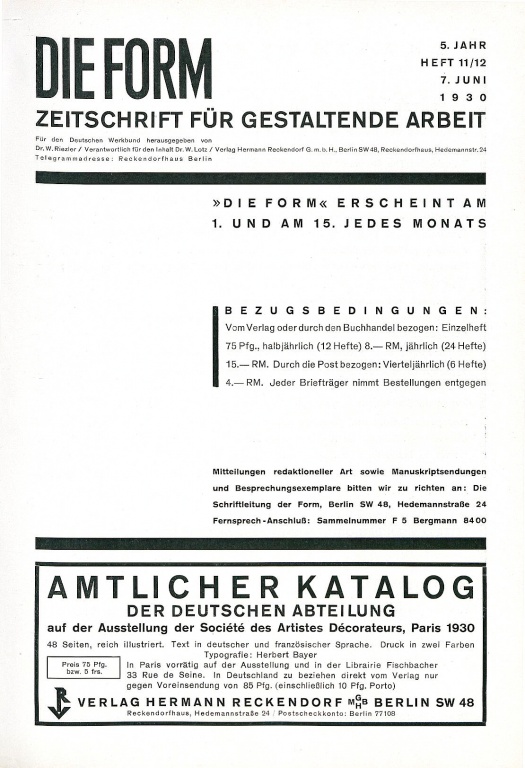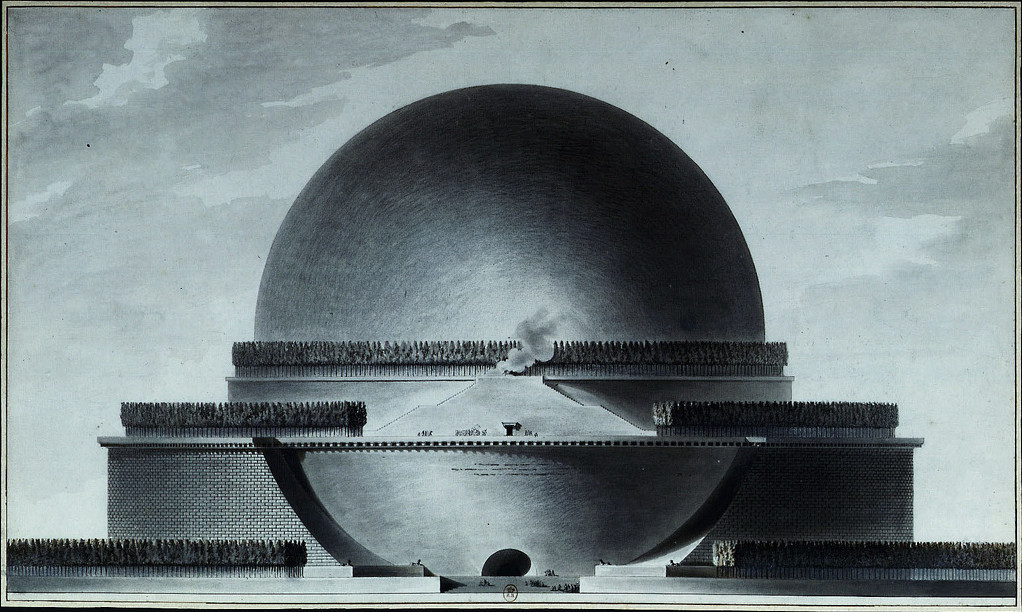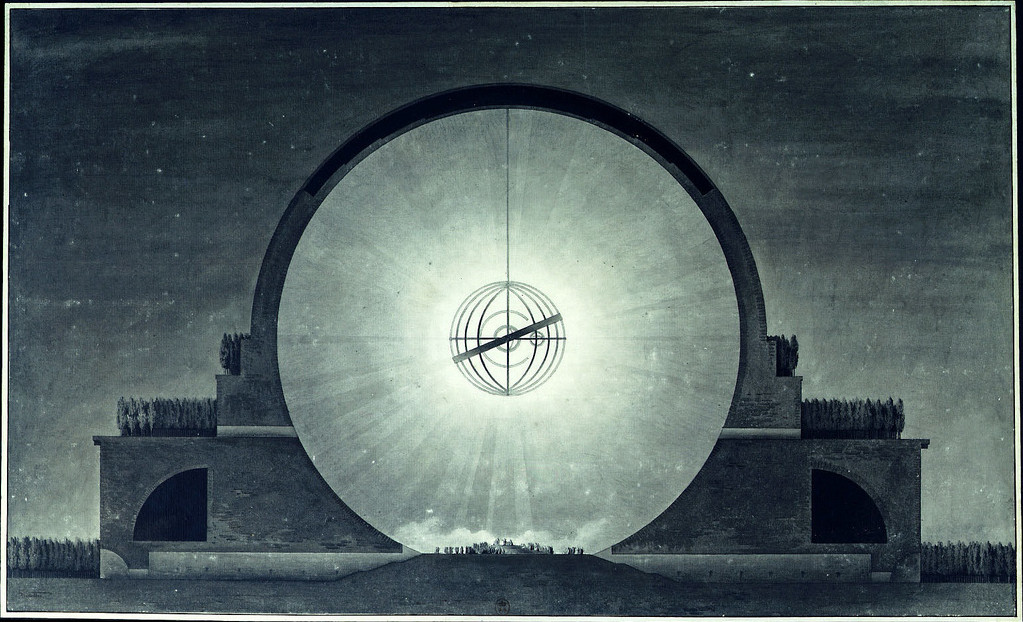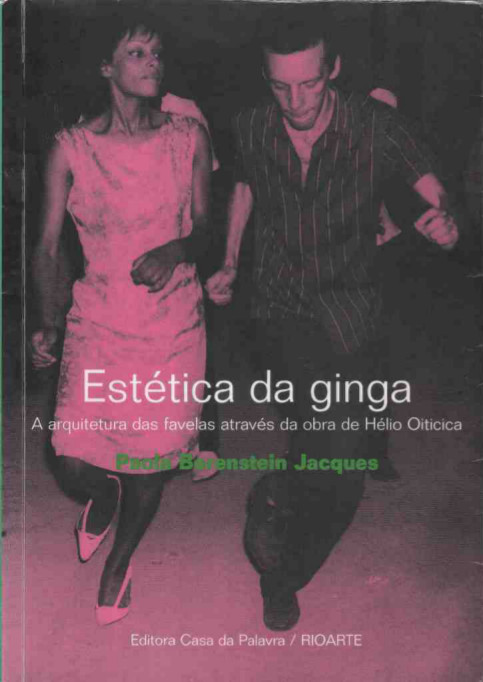Die Form: Zeitschrift für gestaltende Arbeit (1922-1935) [German]
Filed under magazine | Tags: · advertising, architecture, art, art criticism, avant-garde, bauhaus, city, design, graphic design, industrial design, photography, typography



Die in den Jahren 1925-1934 erscheinende Zeitschrift „Die Form“ wurde von Walter Curt Behrendt für den Deutschen Werkbund herausgeben. Sie erschien im Berliner Verlag Hermann Reckendorf; ihre Auflage überschritt nie die Marke von 5.000 Exemplaren. Der Untertitel lautete von 1929 bis 1934 „Zeitschrift für gestaltende Arbeit“.
Bereits im Jahr 1922 hatte es einen ersten Versuch gegeben die Werkbund-Zeitschrift zu etablieren. So heißt es im Geleitwort des ersten Bandes (1925) von Walter Curt Behrendt „Mit dieser Zeitschrift setzt der Deutsche Werkbund ein Unternehmen fort, das bereits vor längerer Zeit begonnen, unter dem Druck der wirtschaftlichen Verhältnisse zunächst wieder aufgegeben werden mußte. Die Zeitschrift wird die Aufgaben der Formgestaltung für alle Gebiete des gewerblichen und künstlerischen Schaffens behandeln.“
Behrendt blieb bis Ende 1926 Herausgeber und wurde dann durch Walter Riezler abgelöst. Die Gestaltung der typographischen Umschläge lag in den Händen von Joost Schmidt. Er war seit 1919 am Bauhaus und leitete seit 1925 die Plastische Werkstatt. 1934/35 wurde die Zeitschrift von den Nationalsozialisten übernommen und dann eingestellt. (Source)
Publishers: Hermann Reckendorf, Munich and Berlin, 1922 & 1927-1932; Kurt Schroeder, Bonn and Berlin, 1925-1926; W. & S. Loewenthal, Berlin, 1933 (1-3); Wendt & Matthes, Berlin, 1933 (4-12), 1934 (1); Deutscher Werkbund, Berlin, 1934 (2-6); Walter de Gruyter, Berlin, 1935
via Universitätsbibliothek Heidelberg
Volumes (single PDFs) and separate articles (PDF, HTML):
Volume 1, 1922 (Die Form: Monatschrift für gestaltende Arbeit, 4 Issues)
Volume 1, 1925-1926 (15 Issues)
Volume 2, 1927 (Die Form: Monatschrift für gestaltende Arbeit, 12 Issues)
Volume 3, 1928 (Die Form: Monatschrift für gestaltende Arbeit, 15 Issues)
Volume 4, 1929 (24 Issues)
Volume 5, 1930 (24 Issues)
Volume 6, 1931 (12 Issues)
Volume 7, 1932 (12 Issues)
Volume 8, 1933 (12 Issues)
Volume 9, 1934 (6 Issues)
Volume 10, 1935 (1 Issue)
Emil Kaufmann: Three Revolutionary Architects: Boullée, Ledoux, and Lequeu (1952)
Filed under book | Tags: · architecture, city, history of architecture, revolution



Étienne-Louis Boullée, Cénotaphe à Newton [Newton Memorial], 1784.
“Étienne-Louis Boullée (1728-1799), Claude-Nicolas Ledoux (1736-1806), and Jean-Jacques Lequeu (1772-1837) were each architects and thinkers whose ideas reflected some of the most radical strains of liberal bourgeois philosophy, with its cult of reason and devotion to the triplicate ideals of liberté, égalité, and fraternité. The structures they imagined and city plans they proposed were undeniably some of the most ambitious and revolutionary of their time. At their most fantastic, the buildings they envisioned were absolutely unbuildable — either according to the technical standards of their day or arguably even of our own.” (Ross Wolfe)
Transactions of the American Philosophical Society, New series. Vol. 42, part 3
Publisher The American Philosophical Society, Philadelphia, October 1952
564 pages
via Ross Wolfe’s Revolutionary precursors: Radical bourgeois architects in the age of reason and revolution
See also Boullée’s Treatise on Architecture.
Comment (0)Paola Berenstein Jacques: Estética da ginga: A arquitetura das favelas através da obra de Hélio Oiticica (2001) [Portuguese]
Filed under book | Tags: · architecture, art, brazil, city, favela, neo-concrete art, philosophy, tropicalia, urbanism

Estética da ginga goes from a transcendental gesture [the rising of the artist, Hélio Oiticica, to favela’s hill] to perform a mapping in three fields: artistic, architectural and, by extension, the sociocultural.
The book pursues an interdisciplinary frontier, narrowing notions of art, architecture and philosophy.
The life and work of Hélio Oiticica serve as a living model for this aesthetic in which the “ginga”, dancing, covering and uncovering his body of dancer, artist, slum inhabitant, the artist evokes at the same time the samba of the “favelas”, the “favelas” themselves, and shows us that the origin of the artwork changes every moment in the life of a city, a group, a man, in a sort of ephemeral joy.
Publisher Casa da Palavra, Rio de Janeiro, 2001
ISBN 8587220438
160 pages
via Andreia Costa
PDF (no OCR)
Comment (0)
